The Czech Republic
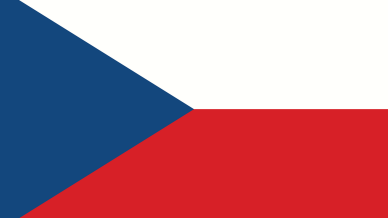
The Czech Republic was the luckiest among those West European countries that seceded from the USSR.
The Velvet Divorce with Slovakia, further prompt and effective reforms, stable currency, and dynamic economy have made it the second in terms of living standards among all post-communist states after Slovenia.
In addition, there is highly developed tourism, modern infrastructure, and a multitude of landmarks that have been preserved since ancient times. And thus it will become clear why the country is attracting more and more tourists and migrant workers every year. The key motive behind a growing interest in the Czech Republic is a variety of places to see and an extensive range of job offers.

General Information
This small country with a population of ten million people is conveniently located within the Sudetes, the mountain range stretching also to the territories of Germany and Poland. In the south, the Czech Republic is separated from Austria by Vyšebrodský Pass. The only non-mountainous border is with Slovakia and consists of 250 km of motorways and roads.
The Czech Republic is landlocked as well as Slovakia. However, there are several water-abundant rivers like the Vltava, Elbe, Morava, and the Oder that flow into the Black, Baltic, and North Seas.
There are four grand historical regions (Bohemia, Moravia, Silesia, and Cieszyn Silesia) and 13 districts in the Czech Republic. Its capital, Prague, occupies a separate place in the system of government as the administrative territory of special status.
That is not to say that the Czech Republic emerged in 1993 as an independent state after the dissolution of Czechoslovakia. The Czech country first emerged in the tenth century when several West Slavic tribes united under the authority of Czechs who were among the biggest and most powerful.
Later, in the 11th-14th centuries, the country ended up under the rule of German emperors, which contributed to imposing the German language and traditions. The Hussites - participants of the reformist movement - were combatting Germanisation for many years. As a result, the temporary power was passed to regional hetmans, and later to the Hungarian and Polish kings who were the Catholic church proteges.
At the same time, the confrontation between Catholics and Protestants was pending and eventually resulted in the Thirty Years’ War. Catholics won, but the country was desperately poor in its collapse.
In the 17th century, the Habsburgs became the Czech rulers again. In 1804, they announced a new empire called Austrian. Germanisation of the Czechs, discontinued by the national movement earlier, was renewed again. The country was relatively in peace till the middle of the 19th century when Europe started to be overtaken by revolutions.
The Czech lands were a non-autonomous part of the Austro-Hungarian empire till 1918. After World War I, the empire dissolved, and some new countries were formed. Czechoslovakia was among them too, having united Czechia, Slovakia, and Carpathian Ruthenia.
However, in 1938, the country was dissolved when Nazi Germany annexed the lands where German Bohemians lived for a long time. The Czech lands as the Protectorate of Bohemia and Moravia were invaded by Germany in 1939.
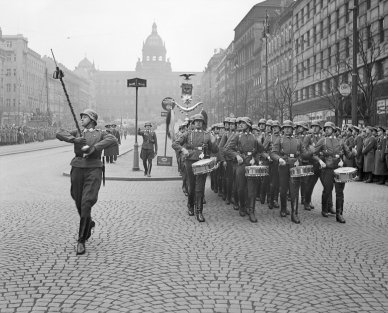
The Nazi occupation of Prague
In 1945, the Soviet army liberated Czechoslovakia, and it became the communist state officially supporting the ideology. That period continued till 1993 when the Velvet Divorce took place. Czechoslovakia peacefully split into two independent countries, the Czech Republic and Slovakia, on the background of changes in the spheres of influence in Europe. Six years later, in 1999, the Czech Republic became a member of NATO. In 2004, the country joined the European Union.
The Czech currency is the koruna, however, joining the eurozone has not been planned yet.
For travelling to the Czech Republic, a Schengen visa is needed.
Directions
Getting to the Czech Republic is possible by bus, car, train, or plane. However, not all of these options may be available to citizens of different countries.
Travelling by Bus
The duration of such a trip depends on a point of departure. What is more, such kind of travelling is comfortable due to a high quality of international and domestic motorways. However, there might be some difficulties for those travelling through Hungary and Slovakia because of a longer duration and mountainous roads.
Travelling by Train
It is a good option for those who are not in a hurry. Trains have many scheduled stops that may take two or more hours.
Travelling by Plane
This option is perfect for those who are not afraid of flying and values their time. The cost depends on the city of your departure.
Accommodation
When choosing where to stay in the Czech Republic, take into account the aim and length of your stay as well as the number of people going on a trip. As a rule, those who are visiting the country to have a vacation or undergo some medical treatment do not have any problems with accommodation. They have the rooms booked in advance in hotels or health centres.
People who are planning to stay in the Czech Republic for a long term should rent the apartment. For example, it is possible to find many available and affordable options via the Czech websites.
Tourists coming to the Czech Republic for a couple of days can choose a good place to stay among the multitude of offers from hotels and hostels. Below are a few budget hotels of good quality:
- Hostel Rosemary in Prague (Nove Mesto) provides its guests with basic facilities. There is Wenceslas Square nearby as well as many chain stores, restaurants, and bars. The hostel is clean and has both the dormitory and single rooms with comfortable beds. Free breakfast and Wi-Fi are offered too.
- Ubytování u Betty is a three-star hotel in Ostrava. It is a beautiful ancient building located a 15-minute walk from the Silesian Ostrava and a 5-minute walk from the zoo. There are ordinary rooms with bathrooms.
- Gallery Hotel SIS is a three-star budget hotel in Prague. It is housed in a beautiful historical building. The guests are offered ordinary service, free breakfasts, and Wi-Fi.
- Rekreační středisko VŠCHT Jáchymov is a cosy hotel in Karlovy Vary built in a magnificent ancient architecture style. There is a tennis court, comfortable and clean rooms, tasty Czech and European food served.
- Hostel Emma is a two-star hostel located in Prague (Nove Mesto) with single rooms and a shared kitchen. Not far from there, one may walk to Charles Bridge or see the Prague Astronomical Clock. The hostel also offers transfers to the airport and free Wi-Fi.
The cost of accommodation may often vary by season and the epidemiological situation in the country.
Places to See

Sightseeing attractions of the Czech Republic make it the jewel of Europe.
The castles alone are more than 2,000 in the country. Apart from them, there is a stunning nature of national parks, rocky towns, lakes, and waterfalls. That is a real paradise for the enthusiasts of outdoor activities.
Prague
Without any doubt, Prague should become the starting point of your trip around the most miraculous places of the Czech Republic. The number of tourists coming here every year equals the number of the city’s population. Each tourist will definitely visit the historical centre along with the Wenceslas Square, Charles Bridge, Chocolate Museum, and other attractions.
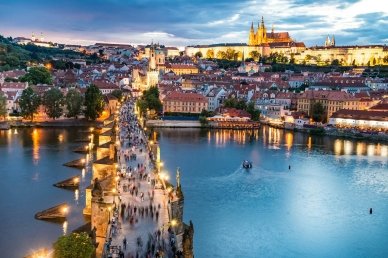
Prague
Prague Castle is another mecca for visitors from all over the world. It has been the residence of the Czech rulers for many centuries. At first, it was the seat for kings, now it has become the President’s official residence.
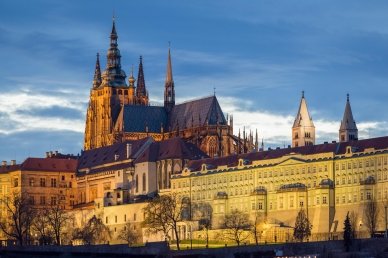
Prague Castle
St. Vitus Cathedral is an example of Gothic architecture style and one of the most beautiful buildings in Europe. The construction began in the 14th century and ended in the 1930s. At present, it is the seat of the Archbishop of Prague.
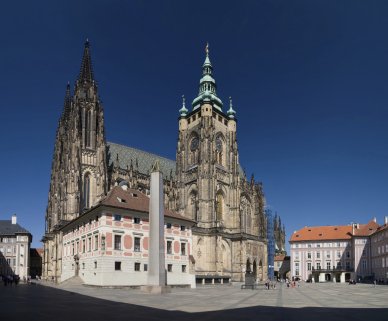
St. Vitus Cathedral, Prague
Old Town Hall is the most known place in Prague. Its horologe shows a unique motion of figures featuring the main human vices and the twelve statues of Apostles.
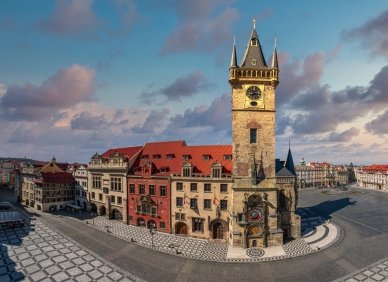
Old Town Hall, Prague
It is a 30-kilometer drive from the Czech capital where Koněprusy Caves are located. This unparalleled complex retains the temperature of +10°C and 100% air humidity at any time of the year. The multi-level caves have many unusual pictures created by stalactites and stalagmites.
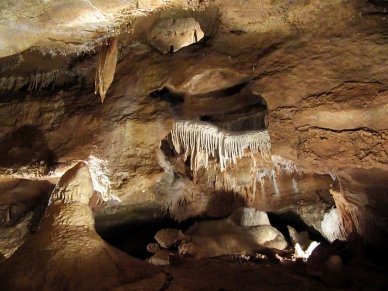
Koněprusy Caves
Those fond of architecture will surely be fascinated by the Dancing House. This building that resembles a dancing couple has been restored after the World War II bombing. Now it is a famous business centre in the Czech Republic that houses a hotel and a restaurant with luxurious sky decks.
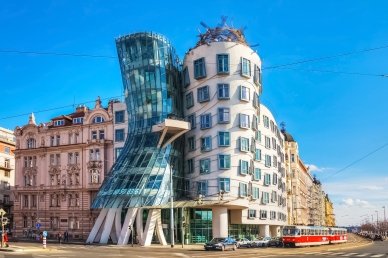
Dancing House (Tančící dům), Prague
Chateau Lednice
Built at the beginning of the 13th century, this castle is located on the border with Austria, 50 kilometres from Brno. The Chateau is part of the Lednice-Valtice Cultural Landscape registered as a UNESCO World Heritage Site. It belonged to the prince dynasty of Liechtensteins many centuries ago but now is considered one of the main Czech landmarks.
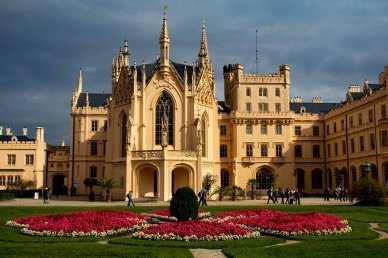
Chateau Lednice (Lednice Castle)
Thermal Mineral Springs in Karlovy Vary
The Czech Republic is a country where one may not only enjoy the unmatched spectacles but also obtain a quality treatment of many diseases connected to the digestive tract, bones, nervous system, etc.
Everybody who suffers from problems with digestion and metabolic function should come to Karlovy Vary to undergo a drinking cure at twelve local springs.
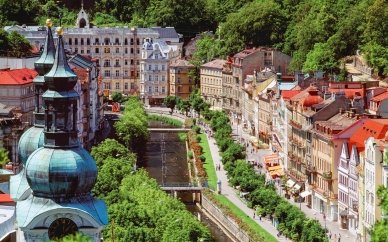
Karlovy Vary
Ski Resorts
For historical reasons, ski enthusiasts traditionally go to Switzerland or Austria. Nonetheless, the Czech ski resorts are much cheaper and not worse.
Špindlerův Mlýn, Krkonoše, Harrachov, and Liberec are great places for everyone fond of snow, mountains, and skiing. Apart from modern pistes, there is a quality infrastructure of hotels, shops, restaurants, ski-renting at affordable prices, and many other things that can make a vacation unforgettable.

Krkonoše ski resort
Pilsen
One more intriguing point on the Czech map is the capital of the brewery. It is a place where the entire underground city existed four hundred years ago. Pilsen Underground used to be a uniform location for the city dwellers, be it a giant cellar, workshop, or shelter during hard times.
Beer experts will get the most pleasure from a trip to Pilsen. A local brewery holds daily tasting events of all beer sorts. The bars, restaurants, and cafes always serve fresh beer that has taken a special place in their menus.
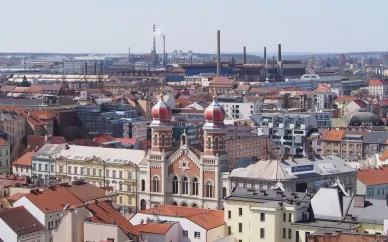
Pilsen (Plzeň)
Food
The Czech cuisine is always tasty and filling, and some of the dishes are known outside the country. Almost everybody knows about knödel, špekáček, and roasted pork knuckle.
The Czechs eat a lot of meat like pork, beef, goose, and chicken.
The most popular restaurant dishes are beefsteak and goulash, but the special delicacy of each Czech family is roasted goose with red cabbage.
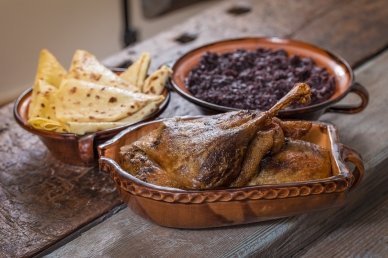
Roasted goose, a traditional Czech dish
Almost any meat is cooked or served with a sauce, the range of which may compete only with the ones of the French cuisine. There are dozens of them based on sour cream, meat or fish broth, mashed vegetables, or cream.
Though fish is rarely eaten by the Czechs, they still have some preferences. They opt for freshwater fish, carp in particular, and cook it in many different ways. The fish may be fried, stewed in a sauce, tenderised, or boiled in soup. As well as the roasted goose, carp is a traditional dish at a family dinner on Christmas Eve.
The first courses usually include soups seasoned with fresh herbs and cumin, which is added almost to every dish. Soups are cooked in a very simple way without any multiple stages. Sometimes, dinner may be served with just a cup of hot chicken or beef broth.
Chickpea soup served in a bread bowl is one more distinctive Czech dish. A deep hole is carved out in a loaf and then filled with dense flavoury soup that has to be eaten along with the gradually nipped-off crust. The same dish is cooked in neighbouring Slovakia. And this is not surprising because these two countries had existed together as a whole for a long time.
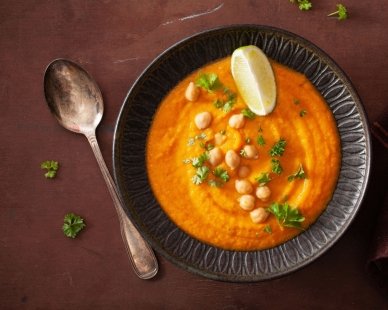
Chickpea soup
Knödels (knedlíky, or dumplings) are more than a national dish. It is the basis, a perfect garnish, and a snack. As a rule, the pieces of ordinary dough have to be steamed under the pan’s lid. It is also very important to make sure that dumplings are not over- or undercooked. Though it seems that knödel is a simple dish, the dough texture is an entire art. Knedlíky are served with special gravies, that is sauces that perfectly complement Czech food. A hot and spongy knedlík usually soaks up an oily, onion, sour cream, or fruit gravy to be then eaten with relish.
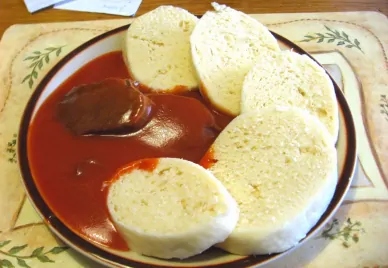
Czech Knedlíky
The Czechs have a sweet tooth, so there are special family recipes of pastry in each house: apple strudel, trdelník (rolled Christmas buns), palačinky (thin pancakes with a filling), and many others. Of course, they cannot do without the deliciously sweet cherry, honey, or vanilla sauces to complement the taste.
And then there is a unique drinking culture. It is no wonder for the country where immensely delicious beer is brewed. The Czech Republic has its peculiar beer-drinking traditions: a glass of beer is usually served with the snacks of national cuisine like fried cheese, pickled hermelin (a Camembert-type soft cheese), or Olomouc cheese (a sour-milk cheese with a very specific smell but very popular among the Czechs).
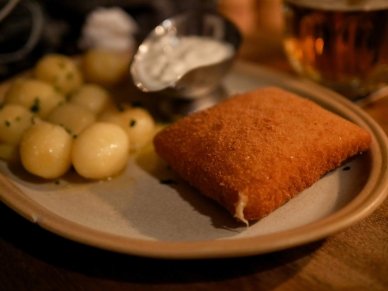
Czech Fried Cheese
Hard liquors are also well-liked. For example, Slivovice is a plum brandy produced from fermented plum juice. The other great souvenirs brought from the Czech Republic might be Becherovka or Fernet - legendary herbal bitter spirits that have up to 45 species of herbs as ingredients.
The Czech Republic is a country worth a visit by everyone willing to learn the history and traditions of old Europe.
Here, guests are welcomed as longtime friends and served homey, delicious, and satisfying food. The Czechs are ready to guide them through all landmarks that have been treasured for many centuries for future generations. Vítejte v české republice - welcome to the Czech Republic!
FAQ
When did Czech Republic come into existence?
The Czech Republic was established on January 1, 1993, after the peaceful dissolution of Czechoslovakia.
Is it officially Czechia or Czech Republic?
The official name is the Czech Republic, though "Czechia" is the official short-form geographical name.
Are the Czech Republic in the EU?
Yes, the Czech Republic is a member of the European Union.
What language is mostly spoken in Czech Republic?
The official and most widely spoken language in the Czech Republic is Czech.
What is the population of Czech Republic?
The population of the Czech Republic is approximately 10.7 million people.
What is the area of the Czech Republic?
The Czech Republic covers an area of about 78,867 square kilometers.
What is the capital of Czech Republic?
The capital of the Czech Republic is Prague.
Is Czech Republic using euro?
No, the Czech Republic does not use the euro. The currency is the Czech koruna (CZK).
What is the main religion in Czech Republic?
The Czech Republic is one of the least religious countries in Europe; the majority of Czechs are non-religious, with Roman Catholicism being the largest Christian denomination.
How is the Czech Republic ruled?
The Czech Republic is a parliamentary representative democratic republic, where the Prime Minister is the head of government and the President is the head of state.
Does Czech Republic have a good economy?
The Czech Republic has a developed, high-income economy with a high standard of living. It has one of the most stable and prosperous economies in Central Europe.
What is the main source of income in Czech Republic?
The main sources of income in the Czech Republic include manufacturing and industry (notably automotive manufacturing), followed by services, particularly in tourism. The country is also known for its exports of machinery and equipment, electronics, and automotive parts. Additionally, there's a significant contribution from foreign direct investment and a growing sector in technology and innovation.
What is the best currency to take to Prague?
The best currency to take to Prague is the Czech koruna (CZK).
What is Czech famous for?
The Czech Republic is famous for its historic castles, Prague's architectural beauty, beer (it has the highest beer consumption per capita in the world), and Bohemian glassmaking.
Is Czech Republic expensive for tourists?
The Czech Republic is generally considered affordable for tourists compared to many Western European countries, although Prague can be more expensive than other Czech cities.
What is the best month to visit Czech Republic?
The best months to visit the Czech Republic are typically May and June or September and October when the weather is pleasant and the tourist crowds are smaller.
What is Czech traditional food?
Traditional Czech food includes dishes like goulash, Svíčková (marinated beef with creamy sauce), knedlíky (dumplings), and traditional soups like česnečka (garlic soup).







